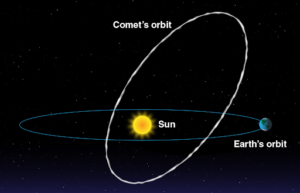In News: The Perseids meteor shower is going to be active from 2020 August 17-26
What is the Perseids meteor shower?
- The Perseids meteor shower peaks every year in mid-August. It was first observed over 2,000 years ago.
- The Perseids occur as the Earth runs into pieces of cosmic debris left behind by the comet Swift-Tuttle.
- The cloud of debris is about 27 km wide, and at the peak of the display, between 160 and 200 meteors streak through the Earth’s atmosphere every hour as the pieces of debris.
- They travel at the speed of some 2.14 lakh km per hour; burn up a little less than 100 km above the Earth’s surface.
What are Meteor Showers?
- Meteors are bits of rock and ice that are ejected from comets as they manoeuvre around their orbits around the sun.
- As meteors fall towards the Earth, the resistance makes the space rocks extremely hot and, as meteorites pass through the atmosphere, they leave behind streaks of glowing gas that are visible to the observers and not the rock itself.
- Meteor showers, on the other hand, are witnessed when Earth passes through the trail of debris left behind by a comet or an asteroid.
- When a meteor reaches the Earth, it is called a meteorite and a series of meteorites, when encountered at once, is termed as a meteor shower.
- According to NASA, over 30 meteor showers occur annually and are observable from the Earth.

Meteor
- It is a space rock or meteoroid that enters Earth’s atmosphere.
- Meteoroids are objects in space that range in size from dust grains to small asteroids.
- Most are pieces of other, larger bodies that have been broken or blasted off. These come from comets, asteroids, planets and the Moon.
- When meteoroids enter Earth’s atmosphere (or that of another planet, like Mars) at high speed and burn up, the fireballs or “shooting stars” are called meteors.
- As the space rock falls towards the Earth, the resistance—or drag—of the air on the rock makes it extremely hot.
- As it passes through the atmosphere, it leaves behind streaks of glowing gas (shooting star) that are visible to the observers.
- Fireballs are larger explosions of light and color that can persist longer than an average meteor streak. This is due to the fact that fireballs originate from larger particles of cometary material.
- When a meteoroid survives its journey through the atmosphere and hits the ground, it’s called a meteorite.
















